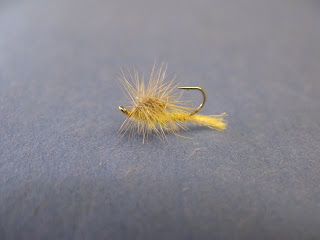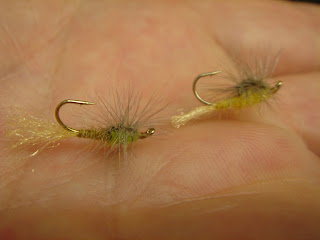Hi,
I am starting a new web site to offer limited fly patterns for sale. Just beginning the site development. It will be at: www.mytroutflies.com
If you have some suggestions for me, please let me know at: byhaugh@mytroutflies.com
Thank you!!!!!
Monday, November 29, 2010
Tuesday, November 23, 2010
Tying a Beadhead Breadcrust
I am re-reading Patrick Dorsey's fine book about tying flies for tailwaters. In it, he tells how he took over the assignment of tying an old pattern - The Breadcrust. The fly at the top is the fly tied by Pat Dorsey - the original pattern referred to in one of the comments below.
The bottom photo is my version tied recently.
I tied this fly with a bead head and I added peacock hearl between the swept back grizzly hackle and the bead head. I think it makes the fly look neater and it adds a material that trout seem to love - peacock hearl.
The somewhat difficult part of tying this fly is that it is done using a split bird feather. It is supposed to be a ruffled grouse. I did not have that bird, so I used a leading wing feather from a partridge. You split the "bone" of the feather lengthwise. Then, you clean the pith material out of the "bone" and soak it in water to make it more pliable. Then, you trim the feather barbules with a scissors fairly close to the middle bone of the feather. Then wrap it forward on a hook which has already been built up slightly with an underbody of smooth yarn tied down.
I think the fly imitates a cased caddis.
Let me know what you think.
Thanks for looking!!!
Friday, November 19, 2010
My Fascination with Dubbing Loop Hackle
I really enjoy tying flies and hackling flies with different materials using a dubbing loop and spinning it to create "hackle".
This particular fly is a Pale Morning Dun. The color may not be exactly right in the photo, but it is in "real life".
In this case, the hackling material is Zelon which is a wonderful material. I did a little internet searching on Zelon and find that it was made by DuPont, but their entire supply was purchased by Umpqua and Blue Ribbon Flies in West Yellowstone. I got mine from Blue Ribbon Flies. Zelon is a shiny material which does not "mat" like most other fibers. Thus, it is used as the shuck on the sparkle comparaduns. If it matted, it would not float so well.
In case you aren't familar with this method: You simply form a thread dubbing loop after reaching the thorax area. Then, cut the Zelon to the appropriate length and spread the fibers in the dubbing loop. Spin the loop until the material forms a "hackle". Then, wrap as you would any hackle.
Let me know what you think. Thanks for looking.

This particular fly is a Pale Morning Dun. The color may not be exactly right in the photo, but it is in "real life".
In this case, the hackling material is Zelon which is a wonderful material. I did a little internet searching on Zelon and find that it was made by DuPont, but their entire supply was purchased by Umpqua and Blue Ribbon Flies in West Yellowstone. I got mine from Blue Ribbon Flies. Zelon is a shiny material which does not "mat" like most other fibers. Thus, it is used as the shuck on the sparkle comparaduns. If it matted, it would not float so well.
In case you aren't familar with this method: You simply form a thread dubbing loop after reaching the thorax area. Then, cut the Zelon to the appropriate length and spread the fibers in the dubbing loop. Spin the loop until the material forms a "hackle". Then, wrap as you would any hackle.
Let me know what you think. Thanks for looking.
Sunday, November 7, 2010
Tying Flies the Upside-Down Paraloop Style
These are my Upside-Down Pale Morning Dun Paraloop imitations.
The sparkle (zelon) trailing shuck is tied dense as it has to help suspend the heaviest part of the hook.
These are easily tied using the JVICE with the gallows attachment. The JVICE can be seen at this website: www.jvice.com





Blue-Winged Olive and the one on the right (above) is a Pale Morning Dun.
The sparkle (zelon) trailing shuck is tied dense as it has to help suspend the heaviest part of the hook.
These are easily tied using the JVICE with the gallows attachment. The JVICE can be seen at this website: www.jvice.com

Blue-Winged Olive and the one on the right (above) is a Pale Morning Dun.
Subscribe to:
Posts (Atom)